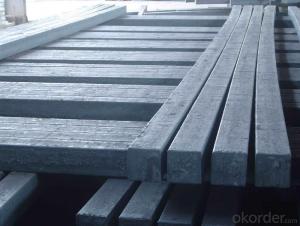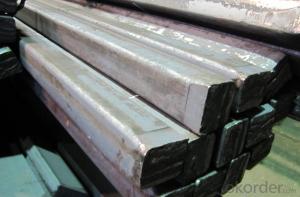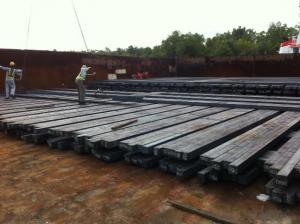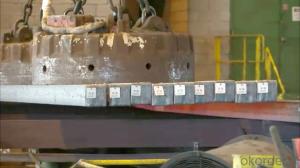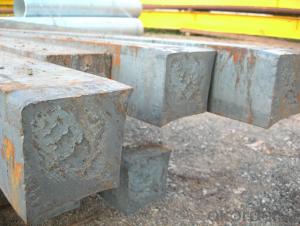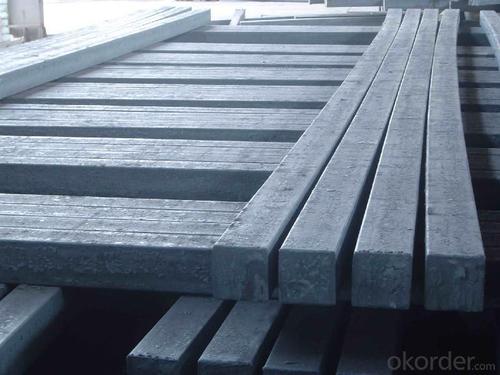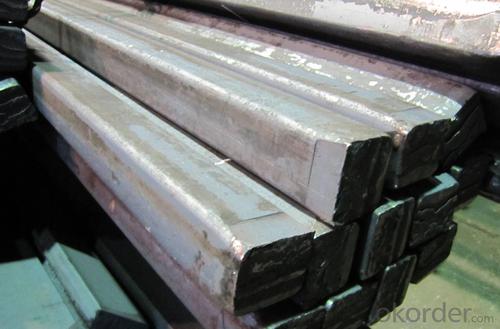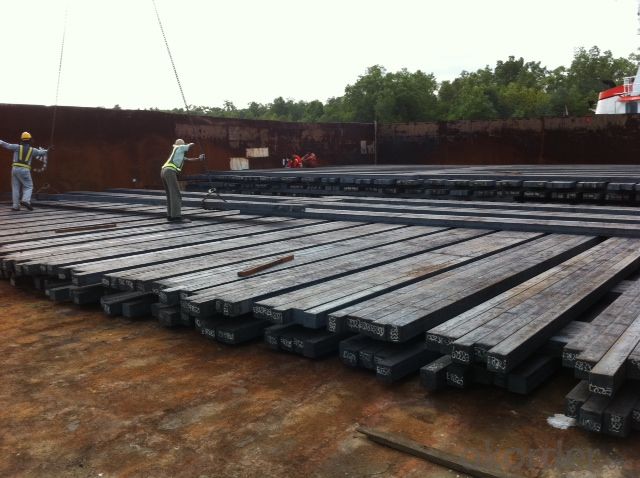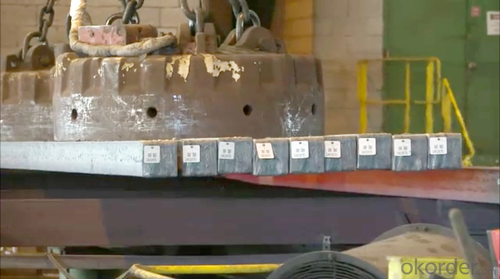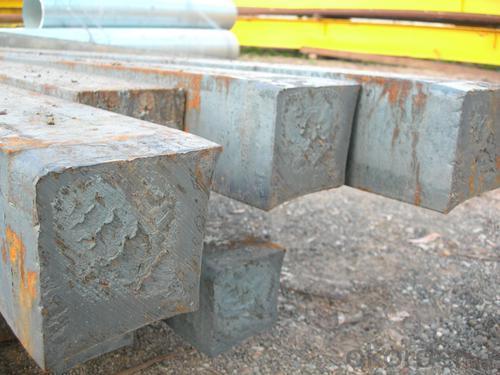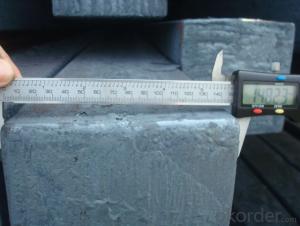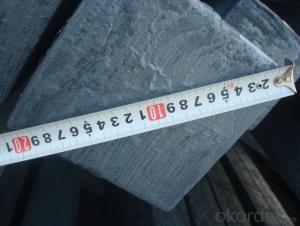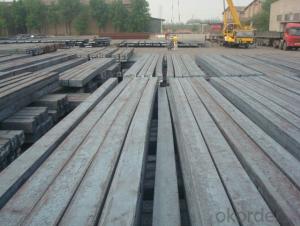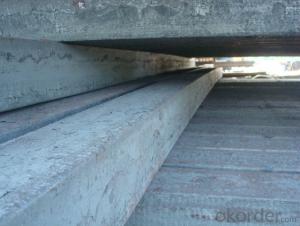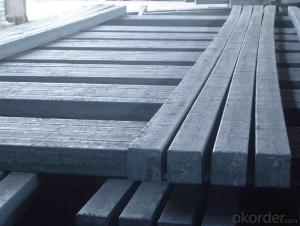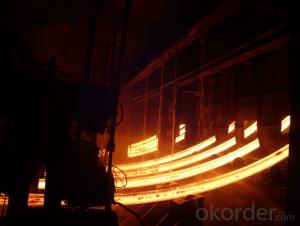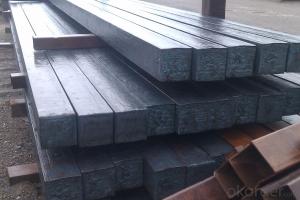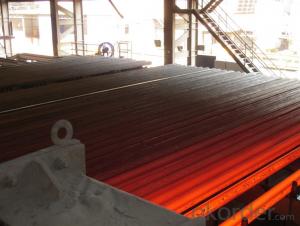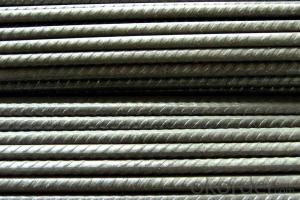Prime square alloy steel billet 155mm Q235
- Loading Port:
- Shanghai
- Payment Terms:
- TT OR LC
- Min Order Qty:
- 100 m.t.
- Supply Capability:
- 10000 m.t./month
OKorder Service Pledge
OKorder Financial Service
You Might Also Like
Structure of Prime square alloy steel billet 155mm Q235
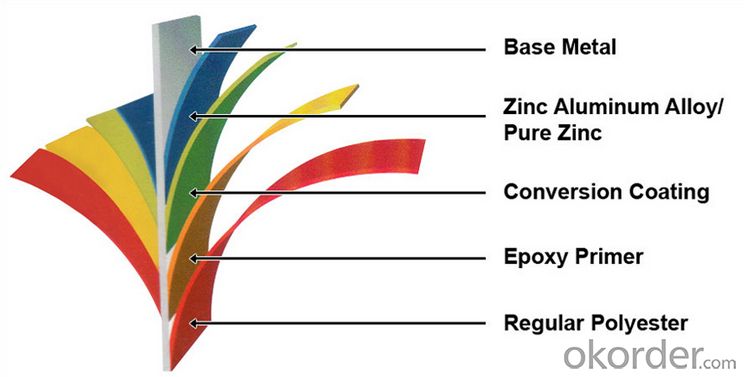
Description of Prime square alloy steel billet 155mm Q235
1) Excellent corrosion resistance: The zinc layer provides a good protection of Pre-painted Galvanizeed Steel Sheet.
2) High heat resistance: The reflective surface of the material aids in efficiently reflecting the sunlight away and in turn reducing the amount of heat transmitted. The thermal reflectivity converts into energy savings.
3) Aesthetics: Pre-Painted Galvanized steel sheet is available in plethora of patterns and multiple sizes as per the requirements that given by our customers.
4) Versatility: can be used in the various areas.
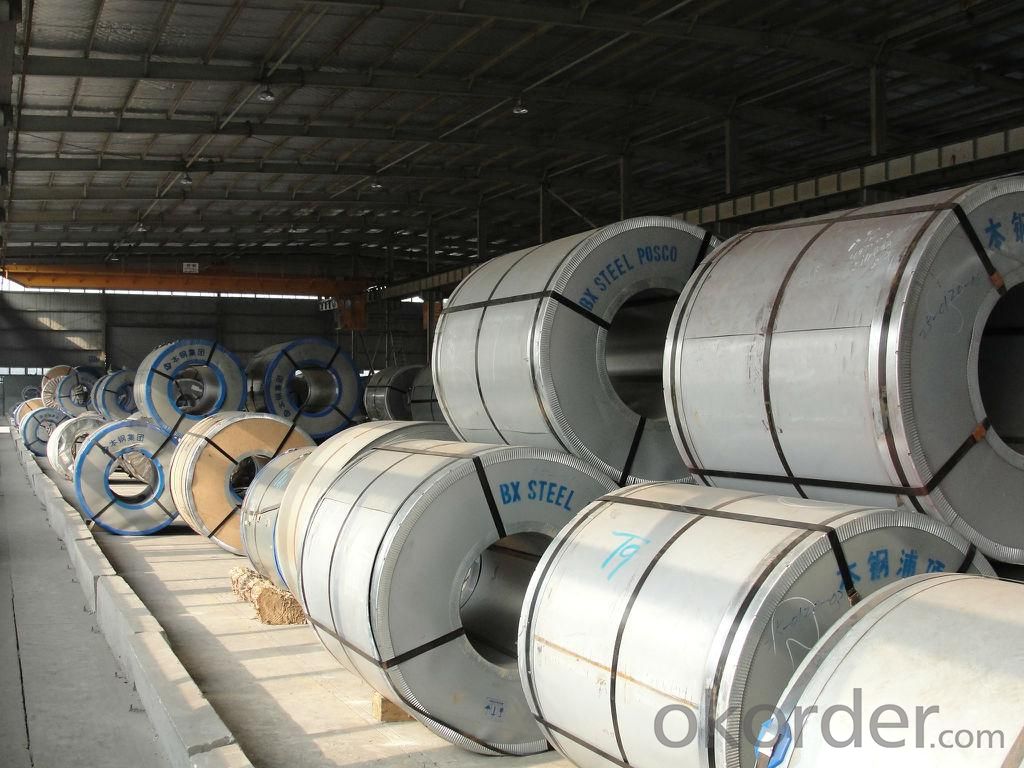
Main Feature of Prime square alloy steel billet 155mm Q235
Uncoated CR steel sheet
With the features of in line with the international highest standards in demension and shape, excellent surface finish and properties, the products are mainly used in home appliance and automobile industries.
Galvanized steel sheet(include HDG and EG)
With the features of good corrosion resistance, the products are mainly used in automobile, home appliance, electronics, building and machinery manufacture industries, etc.
Precoated steel sheet
With the features of enviromental protection and good processablility, long lasting surface durability, rich in colors, the products are maily used in building, home appliance and furniture industries, etc.
Applications of Prime square alloy steel billet 155mm Q235
1) Excellent corrosion resistance: The zinc layer provides a good protection of Pre-painted Galvanizeed Steel Sheet.
2) High heat resistance: The reflective surface of the material aids in efficiently reflecting the sunlight away and in turn reducing the amount of heat transmitted. The thermal reflectivity converts into energy savings.
3) Aesthetics: Pre-Painted Galvanized steel sheet is available in plethora of patterns and multiple sizes as per the requirements that given by our customers.
4) Versatility: can be used in the various areas.
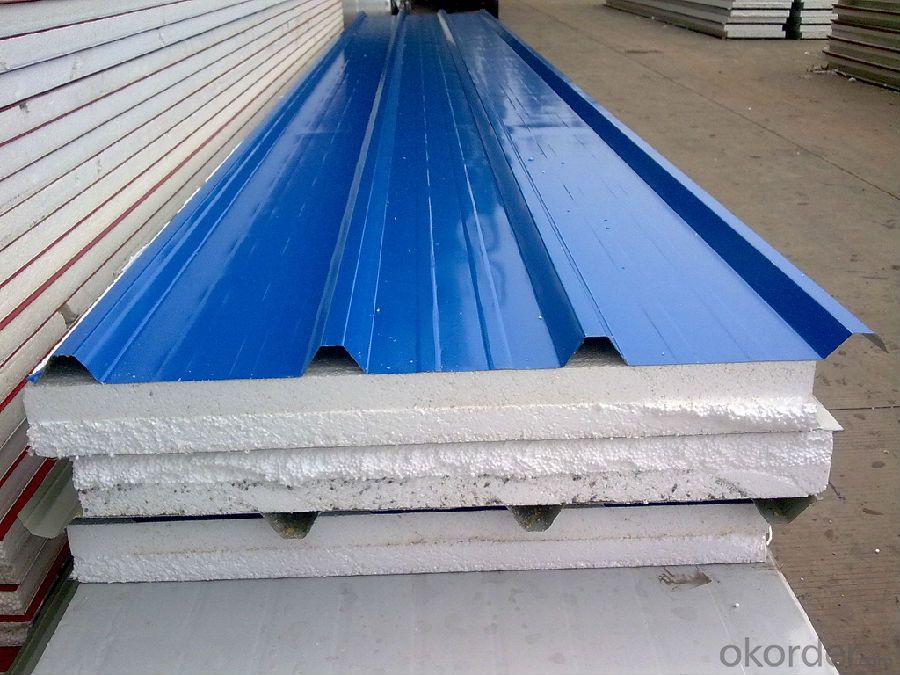
Specifications of Prime square alloy steel billet 155mm Q235
Product | Billet |
Material Grade | SGCC / SGCH / DX51D+AZ, etc |
Thickness | 0.6-3.0mm |
Width | 500-1500mm |
Tolerance | Thickness: +/-0.02mm , Width:+/-2mm |
Zinc-coating | Z30-150g/m2 |
Technique | Raw material: Hot rolled steel coil --> Cold rolled_>hot dipped galvalume |
Surface | Dried, Chromated, Unoiled |
Spangle | Regular spangle , small spangle, zero spangle |
ID | 508MM 610MM |
Coil weight | 1-25MT |
Export package | Cardboard inner sleeves, Waterproof paper, galvanized steel covered and steel strip packed |
FAQ of Prime square alloy steel billet 155mm Q235
We have organized several common questions for our clients,may help you sincerely:
1. How Can I Visit There?
Our company is located in Tianjin City, China, near Beijing. You can fly to Tianjin Airport Directly. All our clients, from home or aboard, are warmly welcome to visit us!
2. How Can I Get Some Sample?
We are honored to offer you sample.
3. Why choose CNBM?
we always fix steel produce in container well to make it safe arrive at destination port
we always provide best and professional forward service for our buyer
we always apply 14days free detention for our buyers container in destination
we provide one set After-sales service for our buyer
we provide China inland steel market price report
we help our buyer become number one in local market .
- Q: What is the average lifespan of a steel billet in the automotive industry?
- The average lifespan of a steel billet in the automotive industry can vary depending on various factors. However, in general, steel billets are typically used as raw materials for the production of automotive parts such as engine components, chassis, and body structures. These parts are designed to have a long lifespan, typically lasting the lifetime of the vehicle itself, which can range from 10 to 20 years or more. The specific duration of a steel billet's lifespan within the automotive industry can also depend on the specific application and the level of stress or wear it undergoes during its service. For instance, engine components like crankshafts or connecting rods may experience higher levels of stress and wear due to the combustion process, potentially requiring replacement or refurbishment after a certain period. Additionally, advancements in material science and manufacturing technologies have led to the development of stronger and more durable steel alloys, further extending the lifespan of automotive parts. These advancements, coupled with regular maintenance and proper usage of the vehicle, contribute to the longevity of steel billets used in the automotive industry. It is essential to note that the lifespan of a steel billet can be influenced by other factors like corrosion, environmental conditions, and the overall quality of the manufacturing process. Therefore, manufacturers and automotive companies prioritize quality control measures to ensure the longevity and reliability of their products. In conclusion, while the specific lifespan of a steel billet in the automotive industry can vary, it is generally designed to last the lifetime of the vehicle, which can range from a decade to multiple decades. Advances in materials and manufacturing techniques enhance the durability and overall performance of steel billets, ensuring their longevity in automotive applications.
- Q: How are steel billets used in the manufacturing of bars and rods?
- Steel billets are an integral component in the manufacturing process of bars and rods. These billets, which are cylindrical in shape, serve as the starting point for producing various types of bars and rods. To begin with, steel billets are often made through a process called continuous casting. This involves pouring molten steel into a mold, which then solidifies and forms a billet. The billets are typically heated to a specific temperature to improve their workability and reduce the risk of cracking during subsequent processes. Once the billets are prepared, they are sent to rolling mills where they are subjected to intense pressure and high temperatures. This process, known as hot rolling, involves passing the billet through a series of rollers to gradually shape it into the desired form. The rolling mills can be equipped with different types of rolls, such as flat rolls or grooved rolls, depending on the specific requirements of the bar or rod being produced. During the hot rolling process, the billet is elongated and reduced in cross-sectional area, resulting in a longer and thinner product. This transformation allows for the production of bars and rods with consistent dimensions and improved mechanical properties. The hot rolling process also refines the grain structure of the steel, enhancing its strength and toughness. After hot rolling, the bars or rods may undergo further processes to achieve specific characteristics. These additional processes may include quenching and tempering, which aim to optimize the mechanical properties of the final product, such as hardness and ductility. In summary, steel billets play a crucial role in the manufacturing of bars and rods. They are transformed through the hot rolling process to achieve the desired shape, dimensions, and mechanical properties. The versatility of steel billets allows for the production of a wide range of bars and rods used in various industries, including construction, automotive, and manufacturing.
- Q: How do steel billets contribute to the overall durability of a product?
- Steel billets play a crucial role in elevating the overall durability of various products, and their contribution cannot be overstated. These semi-finished steel products serve as raw material for further processing in industries such as construction, automotive, and manufacturing. A key factor in the enhanced durability provided by steel billets is their superior strength and toughness. Steel is renowned for its exceptional mechanical properties, including high tensile strength and resistance to deformation, making it an optimal choice for applications that require durability. By utilizing steel billets as the initial material, manufacturers can guarantee that the final product will possess the necessary strength to endure heavy loads, impacts, and external forces. Additionally, steel billets exhibit outstanding corrosion resistance. With proper processing and treatment, steel can withstand rust and other forms of corrosion caused by moisture, chemicals, or environmental factors. This corrosion resistance significantly enhances the durability of the end product by preventing degradation and extending its lifespan. Another advantage of employing steel billets lies in their versatility for customization. Manufacturers can shape and form the billets into various sizes and dimensions to meet the specific requirements of the product. This flexibility enables the production of components that fit together perfectly, reducing the risk of weak points or vulnerabilities in the overall structure. Furthermore, steel's malleability and ductility allow for easy molding and welding, further enhancing the overall strength and durability of the final product. Furthermore, steel billets undergo stringent quality control measures during the manufacturing process. These measures ensure that the billets meet rigorous industry standards and specifications, guaranteeing their reliability and consistency. The utilization of high-quality steel billets, in turn, contributes to the overall durability of the product by providing a sturdy and dependable foundation. In conclusion, steel billets play a pivotal role in enhancing the overall durability of products. Their exceptional strength, corrosion resistance, versatility, and high-quality attributes make them an optimal choice for industries that prioritize durability. By utilizing steel billets as the raw material, manufacturers can create products capable of withstanding demanding conditions, ensuring longevity and customer satisfaction.
- Q: How are steel billets used in the manufacturing of railway wagons?
- Steel billets are used in the manufacturing of railway wagons as they serve as the raw material for various components such as frames, side panels, and undercarriages. These billets are first heated and then shaped into the desired form through processes like rolling or forging. The resulting components are strong, durable, and able to withstand the rigorous demands of railway transportation, ensuring the safety and reliability of the wagons.
- Q: How do steel billets contribute to the overall cost-effectiveness of a project?
- Steel billets contribute to the overall cost-effectiveness of a project by providing a cost-efficient raw material for manufacturing various steel products. They can be easily melted and transformed into different shapes and sizes, minimizing waste and reducing production costs. Additionally, the strength and durability of steel billets make the finished products long-lasting, reducing maintenance and replacement expenses.
- Q: How do steel billets contribute to the manufacturing of packaging materials?
- Steel billets are used in the manufacturing of packaging materials as they provide the necessary strength and durability required to create sturdy and long-lasting packaging products. The steel billets are melted and formed into various shapes and sizes, which are then used to create packaging containers, cans, and other materials. These packaging materials are essential for safely storing and transporting goods, protecting them from external elements and ensuring their integrity throughout the supply chain.
- Q: What are the main factors that influence the strength of steel billets?
- The strength of steel billets is impacted by various factors, including the chemical composition, heat treatment, and microstructure of the steel. The chemical composition plays a significant role in determining the strength of steel billets. Alloying elements like carbon, manganese, silicon, and chromium can enhance strength by forming solid solutions or precipitates that increase hardness and tensile strength. It is crucial to control impurity levels and maintain the desired balance of alloying elements to achieve the desired strength properties. Heat treatment is another important factor that affects the strength of steel billets. This process involves heating the steel to a specific temperature and then cooling it at a controlled rate. It significantly impacts the microstructure of the steel, which ultimately influences its strength. For example, quenching and tempering can result in the formation of desired microstructures like martensite or bainite, which enhance strength and toughness. The microstructure of steel billets also plays a crucial role in determining their strength. The arrangement of crystal grains and the presence of different phases within the steel greatly influence its mechanical properties. Fine-grained structures generally exhibit higher strength due to a greater number of grain boundaries, which inhibit dislocation movement and enhance strength. Additionally, the presence of specific microstructural features like precipitates or second-phase particles can contribute to the strength of steel billets. Other factors such as the manufacturing process, cooling rate during solidification, and mechanical working (such as rolling or extrusion) can also affect the strength of steel billets. These factors impact grain size, grain boundary density, and defect concentration, all of which influence the mechanical properties of the steel. In conclusion, the strength of steel billets is influenced by the chemical composition, heat treatment, and microstructure of the steel. These factors can be carefully controlled and optimized to achieve the desired strength properties for various applications.
- Q: Iron type frequency furnace, billet 150, continuous casting billet between the hole, please help net friend to find the original, please ask non answer, not Xie, please mention, understand enough, please resume me
- Production: 1 steel and 2 steel alloy or damp; for ladle lining refractory and no baking; otherwise the whole section are 3 billet bubble deposit if the situation is steel quality problems and the main problems of alloy billet; if the bubble is mainly between now and the relationship between process equipment (including continuous casting are clearly some problems of continuous casting machine the parameters of a)
- Q: How do steel billets contribute to the manufacturing of telecommunications equipment?
- Steel billets play a crucial role in the manufacturing of telecommunications equipment by providing the necessary raw material for various components and structures. These billets, typically made from carbon steel, are semi-finished products that are further processed to create specific shapes and sizes required for telecommunications equipment. One of the key ways steel billets contribute to the manufacturing of telecommunications equipment is by serving as the base material for the fabrication of towers and masts. These structures are vital for the installation of antennas and satellite dishes, enabling the transmission and reception of signals for telecommunications networks. Steel billets are shaped and welded to create sturdy and durable towers that can withstand various environmental conditions. Moreover, steel billets are also used in the production of enclosures and cabinets for housing telecommunication equipment. These enclosures provide protection from external factors such as dust, moisture, and vandalism, ensuring the proper functioning and longevity of the equipment. Steel billets are formed into panels, frames, and chassis that are then assembled to create robust enclosures that can withstand harsh environments. In addition, steel billets contribute to the manufacturing of telecommunications equipment by being used in the production of cable trays and supports. These components are essential for organizing and routing cables, providing a neat and efficient infrastructure for telecommunications systems. Steel billets are rolled and formed into various shapes, such as channels and angles, to create sturdy cable trays and supports that can handle the weight and stress of multiple cables. Furthermore, steel billets are also utilized in the fabrication of connectors and brackets for telecommunications equipment. These small yet crucial components provide the necessary connections and support for different devices and modules in telecommunications systems. Steel billets are machined, drilled, and shaped into specific designs to create reliable connectors and brackets that ensure proper functionality and stability. Overall, steel billets play a vital role in the manufacturing of telecommunications equipment by providing the necessary raw material for various components and structures. Their strength, durability, and versatility make them an ideal choice for creating robust and reliable equipment that can withstand the demands of modern communication networks.
- Q: How are steel billets used in the production of construction machinery attachments?
- Steel billets are an essential component in the production of construction machinery attachments. These billets serve as raw materials that are shaped and transformed into various parts and components of the attachments. Firstly, the steel billets are heated to high temperatures to make them malleable and easier to work with. They are then passed through a series of specialized machines, such as rolling mills and forging presses, where they are shaped into the desired form. This process allows the billets to be transformed into different components, such as bars, plates, and rods, which are crucial for the construction machinery attachments. Once the billets have been shaped, they undergo further processes such as cutting, drilling, and shaping to create specific parts of the attachments. For example, billets can be cut and shaped to form the teeth of excavator buckets or the blades of bulldozer attachments. These parts need to be durable and strong to withstand the demanding conditions of construction sites, and steel billets provide the necessary strength and resilience. Moreover, the use of steel billets ensures that the construction machinery attachments can withstand heavy loads, impacts, and extreme temperatures. Steel is known for its high strength-to-weight ratio, making it an ideal material for construction machinery attachments. It can withstand the harsh conditions of construction sites and provide longevity to the attachments, resulting in improved performance and reliability. In summary, steel billets are a crucial component in the production of construction machinery attachments. They are shaped and transformed into various parts and components, ensuring durability, strength, and longevity. By using steel billets, construction machinery attachments can effectively perform their intended functions and withstand the demanding conditions of construction sites.
Send your message to us
Prime square alloy steel billet 155mm Q235
- Loading Port:
- Shanghai
- Payment Terms:
- TT OR LC
- Min Order Qty:
- 100 m.t.
- Supply Capability:
- 10000 m.t./month
OKorder Service Pledge
OKorder Financial Service
Similar products
Hot products
Hot Searches
Related keywords
